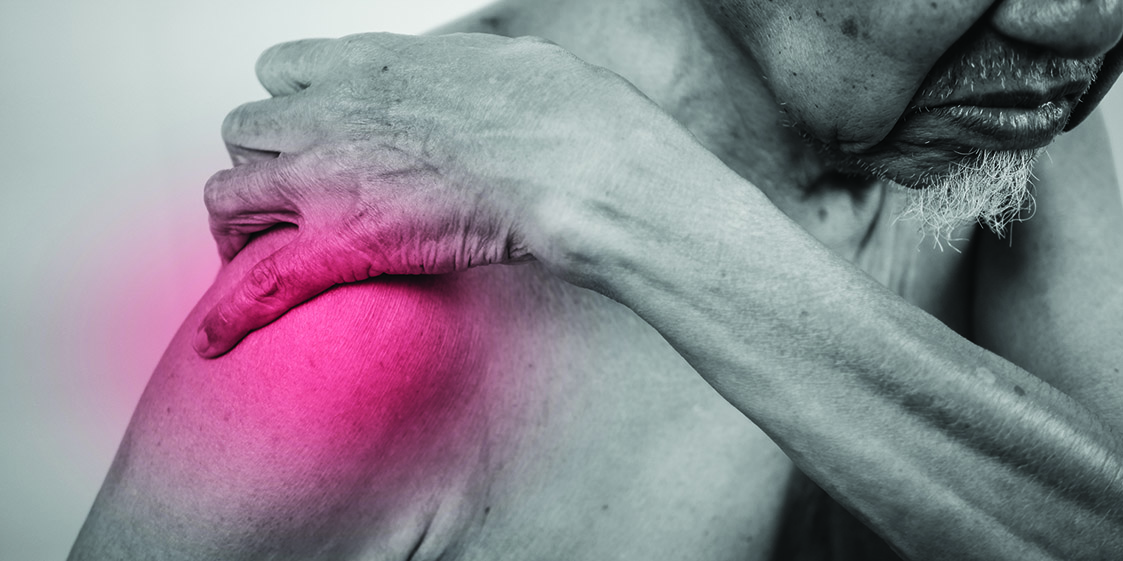In this series, Dr Andrew Jordan seeks to demystify for non-rheumatologists how a rheumatologist thinks about and approaches common presentations
My aim is to present a common case and work through the reasoning of which tests I order and why, what questions are most useful to help diagnose this condition and a simple approach to management. The approach is practical and based upon experience and evidence, where it exists.
A 71-year-old male presents with two months of symptoms, especially severe over the last three weeks. It started with left shoulder pain and restriction of movement, followed a few days later by right shoulder pain and restriction of movement.
Five weeks ago, he developed buttock, lateral hip and hamstring pain. Three weeks ago,both hands became painful and the right hand and fingers were numb at night. His neck was painful overnight and in the morning. Morning stiffness lasted three hours. Just prior to presentation he was sleeping in a chair as it was so uncomfortable lying in bed. He is a lifelong smoker but otherwise healthy. Examination showed reduced shoulder movement in all directions with inability to raise arms above shoulder height.
There was synovitis at the wrists and he could not make a full fist. Phalen’s test was positive. There was tenderness over the trochanteric region and irritability of hip movement. There were no knee effusions or synovitis in his feet and he didn’t report problems in these areas.
The first consideration in differentiating rheumatic diseases is inflammatory versus mechanical causes. The key questions are the duration of morning stiffness and the dominant pain being at rest or overnight.
The length of morning stiffness is a guide to severity and I regard more than 30 minutes of morning stiffness as more likely to be inflammatory joint pain. The presentation fits an inflammatory problem.
The pattern of joint involvement is important. He presents with shoulder and pelvic girdle pain as well as hand involvement. There is sparing of knees and feet.
My primary consideration here is polymyalgia rheumatica (PMR). The other main differential diagnosis is that of rheumatoid arthritis, but there are many less-common inflammatory conditions that are possible.
My general rule is that hand and wrist involvement is allowed at initial presentation in PMR as long as it settles quickly on prednisone. If the feet are affected, then it is not PMR. Knee involvement is not common in PMR.
Basic investigations show C-reactive protein (CRP) is 67 (N<5) and erythrocyte sedimentation rate (ESR) is 54 (N<21), both significantly raised. Rheumatoid factor (RF) and anti-CCP antibody are negative.
I order these tests in anyone with suspected PMR.
In the elderly population, rheumatoid arthritis can present in a “polymyalgic fashion” with only shoulder and pelvic girdle pain, clinically indistinguishable from PMR. If RF or anti-CCP antibodies are positive, then this presentation is likely to be that of rheumatoid arthritis.
I order a chest X-ray given the long history of smoking. Rarely, inflammatory arthritis is a manifestation of a paraneoplastic effect.
The next key consideration is to ask the correct questions to consider giant cell arteritis (GCA). This should be done in all patients where PMR is considered as there is overlap between the conditions.
The most specific symptom for GCA is jaw claudication. Ask “Does your jaw hurt when chewing food?”
A daily headache in an elderly person who does not normally get headaches is concerning. The headaches may not be severe and can be relieved with simple measures such as paracetamol, only to return. I also ask about scalp dysaesthesia. “Does your scalp feel numb or tingly when touching it or brushing your hair?”
Visual symptoms are a very late sign. Often the first eye problem is sudden onset irreversible unilateral blindness. Of course, the aim is to diagnose and treat before this devastating event. Diagnosis of GCA requires a temporal artery biopsy which is usually performed by a vascular or ophthalmic specialist. If I suspect GCA, I will treat with prednisone at much higher doses than I use to treat PMR (1mg/kg) and aim to get a biopsy ideally within one week of starting prednisone. The rate of false negative biopsies increases after two weeks of prednisone use.
The patient was diagnosed with PMR. Consequently, he was started on prednisone 15mg daily. Symptoms dramatically improved within two days, as should be the case for PMR. This condition is one of the most “steroid sensitive” diseases we treat and high doses are not required.
I anticipate the patient will remain on prednisone for 18 to 24 months (on average) with a very slow tapering dose.
Cohort studies show that 10 to 20% of patients with PMR remain on prednisone indefinitely.
Rheumatologists have different tapering schedules for prednisone. A common mistake is stopping prednisone too soon, or the converse, starting with the dose too high and not reducing. Most of the treatment course is on lower doses of below 7mg daily. Even a dose reduction of 1mg of prednisone can result in a flare. If a patient experiences an increase in typical pain with a slight rise in CRP or ESR, I increase the prednisone dose to the last effective dose. This may only be a 1-2mg increase. Rarely does the dose need to be dramatically increased.
I always maintain a high index of suspicion when treating PMR as most cohort groups show that 20 to 30% of patients have a change in diagnosis during their disease course. This shows how many conditions have a similar presentation and how we lack precise tests to differentiate these conditions.
Clinical acumen is paramount.
Dr Andrew Jordan is a rheumatologist based in Paramatta, Sydney, with a special interest in inflammatory arthritis, gout and osteoporosis


